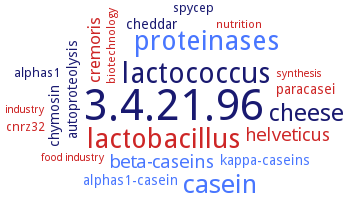3.4.21.96: Lactocepin
This is an abbreviated version!
For detailed information about Lactocepin, go to the full flat file.
Reaction
Endopeptidase activity with very broad specificity, although some subsite preferences have been noted, e.g. large hydrophobic residues in the P1 and P4 positions, and Pro in the P2 position. Best known for its action on caseins, although it has been shown to hydrolyse hemoglobin and oxidized insulin B chain
=
Synonyms
cell envelope associated proteinase, cell envelope proteinase, cell wall anchored proteinase, Cell wall-associated serine proteinase, cell-bound cell envelope proteinase, Cell-envelope proteinase, Cell-envelope-located serine proteinase, Cell-wall-bound proteinase, CEP, Extracellular lactococcal proteinase, Lactocepin, Lactocepin I, lactococcal cell envelope proteinase, Lactococcal cell envelope-associated proteinase, Lactococcal cell wall-associated proteinase, Lactococcal PI-type proteinase, Lactococcal PIII-type poteinase, Lactococcal proteinase, Lactococcal proteinase PI, LP151, PrtH, PrtH2, PrtP, PrtP proteinase
ECTree
Application
Application on EC 3.4.21.96 - Lactocepin
Please wait a moment until all data is loaded. This message will disappear when all data is loaded.
Please wait a moment until the data is sorted. This message will disappear when the data is sorted.
biotechnology
conversion of lactocepin substrate binding regions by allele exchange can effectively alter lactocepin specificity in industrial strains of Lactococcus lactis without significantly affecting other important strain properties. The methodology can be used to alter lactocepin specificity in commercial starter cultures with a propensity for bitter flavour defect
nutrition
-
cheese making, cheese starter organism, dairy industry
additional information
-
exposure of PrtP, and not its proteolytic activity, is responsible for greater cell hydrophobicity and adhesion. The increased bacterial affinity to polar and apolar solvents indicates that exposure of PrtP on lactococcal cell surface can enhance the capacity to exchange attractive van der Waals interactions, and consequently increase their adhesion to different types of solid surfaces and solvents. PrtP or its derivatives may be used as a tool to construct strains with increased adhesion that form protective biofilms
food industry

-
CEP isolated from Mongolian fermented mare's milk strain SBT11087 is distinct from those from previously reported Lactobacillus helveticus strains in terms of its optimal temperature and its degradation of beta-casein
food industry
-
CEP isolated from Mongolian fermented mare's milk strain SBT11087 is distinct from those from previously reported Lactobacillus helveticus strains in terms of its optimal temperature and its degradation of beta-casein
-
industry

method to alter lactocepin specificity in commercial starter cultures with a propensity for bitter flavour defect. PrtP derivatives developed by this approach should be suitable for commercial applications in the US and other countries with a favourable regulatory climate
industry
-
method to alter lactocepin specificity in commercial starter cultures with a propensity for bitter flavour defect. PrtP derivatives developed by this approach should be suitable for commercial applications in the US and other countries with a favourable regulatory climate
-
synthesis

-
optimisation of enzymatic hydrolysis of beta-casein to produce the angiotensin-I-converting enzyme (ACE) inhibitory peptides. Under optimal conditions (enzyme-to-substrate ([E]/[S]) ratio (w/w) of 0.132 and pH of 8.00 at 38.8°C), the ACE inhibitory activity of hydrolysates is 72.06% and the total peptides is 11.75 mg/ml. The resulting hydrolysates have higher thermal stability than beta-casein and show an increase in the free sulfhydryl content compared with raw beta-casein
synthesis
-
optimisation of enzymatic hydrolysis of beta-casein to produce the angiotensin-I-converting enzyme (ACE) inhibitory peptides. Under optimal conditions (enzyme-to-substrate ([E]/[S]) ratio (w/w) of 0.132 and pH of 8.00 at 38.8°C), the ACE inhibitory activity of hydrolysates is 72.06% and the total peptides is 11.75 mg/ml. The resulting hydrolysates have higher thermal stability than beta-casein and show an increase in the free sulfhydryl content compared with raw beta-casein
-




 results (
results ( results (
results ( top
top






